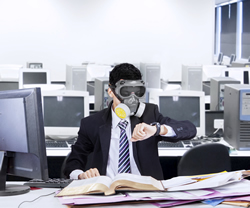Chris Stokel-Walker* says while the health impacts of outdoor pollution are well known, less recognised is the poor air quality of many indoor work environments.

Photo: Creativa Images
Chris Birch used to dread afternoon meetings at the old office of his engineering consultancy.
The windows in the conference rooms (and the rest of the office) were kept shut all year round.
But sealing the building meant every breath an employee took during those long meetings would raise the carbon dioxide level in the room, causing drowsiness and headaches.
“The problem we had for 20 years was that when conditions in the office got stuffy or hot, you’d open a window for ventilation and be hit by a wall of noise and air pollution,” Birch says.
Obviously, this workspace isn’t unique — nor is the experience of developing a throbbing head and even difficulty breathing as we go about our daily lives in offices.
Having airconditioning doesn’t help unless the system includes proper filters, as the outdoor air — potentially filled with pollutants — is sucked indoors and circulated around the office.
Yet there’s not great awareness of the issue.
We all notice air quality in our outdoor environment but less so indoors.
Cath Noakes, a professor at the University of Leeds’ School of Civil Engineering who has researched indoor air quality, says the issue has long been overlooked.
Yet it shouldn’t be.
The health impacts of poor outdoor air quality are well known — respiratory tract infections, lung cancer and chronic obstructive pulmonary disease.
People often think the answer is to escape indoors — but that’s not true.
According to the US Environmental Protection Agency (EPA), air pollution indoors is often between two and five times greater than outdoors — and at its extreme can be up to 100 times worse.
“Indoor air contains whatever pollution you have outside, plus whatever you are adding inside a building, like … fumes from cleaning products and building materials,” explains Matthew S. Johnson, Chief Science Officer at Airlabs, which installs air filtering technology.
According to The Lancet, 800,000 people die every year due to poor air quality in their workplace.
“In addition, ‘sick building syndrome’ can cause headaches and loss of productivity,” Johnson says.
Most developments in indoor air cleaning have come from engineers in Asia, where fossil fuel dependency and weak regulation have created some of the world’s most polluted cities.
“China continues to lead the way with regards to indoor environment quality monitoring, in part due to the prevalence of outdoor air pollution across significant parts of the country,” says Matthew Clifford, head of energy and sustainability in Asia Pacific for JLL.
“Aside from avoiding the negative impacts of poor air quality, improving indoor air has many positive benefits, including increased productivity.”
In Beijing, which is known for its severe smog, a 2015 report by real estate firm JLL and environmental consultancy Pure Living found that 90 per cent of office buildings were not achieving substantive reductions of pollutants on bad-air days.
But people are taking action.
The number of air purifiers in China is rising substantially, and a report last year said manufacturers were innovating to meet demand, “using nanotechnology, increasing energy efficiency and reducing the noise levels”.
Employers are also seeing the benefits of investing.
Innovation and awareness are also travelling outside Asia.
Airlabs is installing systems in London shops after businesses recognised that levels of nitrogen dioxide inside stores on Oxford Street and Bond Street were similar to levels on the street outside.
At the moment there are no strict rules around the standard of air we breathe in workplaces around the world, although the World Health Organisation developed guidelines in 2009 for indoor air quality.
Experts are unsure about the benefits of hard regulation.
Simply setting a limit on the number of parts per million of troublesome pollutants allowed indoors can be arbitrary.
Every building is different, and hard figures don’t account for office visitors whose breathing can push it above safe levels.
Luckily for those of us cooped up in offices every day, more employers are taking action.
Chris Birch’s office moved to a new building a few years ago, which allowed them to design their workplace from scratch and tackle the problem at source.
Some actions were obvious: installing air filters that get rid of some of the most harmful pollutants.
They also installed a number of air quality monitors that continuously check the levels of carbon dioxide, nitrogen dioxide and particulates in the air and warn if they reach an unacceptable level.
The office also got a lot greener.
“We looked at a piece of research NASA did that investigated plants that actively clean the air,” says Birch.
They picked a handful from a list of the top 10 most efficient and put them in their new office.
Then, says Birch, there was the “new car-like smell”.
It’s produced by volatile organic compounds from paints, adhesives, furniture and carpets used in the building that leach into the air for several years in a process known as “offgassing”, explains Noakes.
To avoid this, Birch’s company sought out low-pollutant materials for their furniture and fittings as certified by the International WELL Building Institute.
It was a difficult task.
“A lot of the furniture and carpet manufacturers at that stage hadn’t yet got their head around it,” explains Birch.
At the same time, the company asked its staff to complete a standard worker wellbeing survey, using a common methodology called BUS (or building use studies).
They’d done the same survey in the old office, where it came out in the lowest 10 per cent of 650-odd other office buildings.
“We did the survey again in this office and were in the top 2 per cent,” Birch says.
“I don’t feel a tangible difference in the air quality,” admits Birch.
But he manages to stay awake through those long afternoon meetings — headache-free, too.
* Chris Stokel-Walker is a British writer. He tweets at @stokel and nhis website is stokel-walker.co.uk.
This article first appeared at www.bbc.com.








